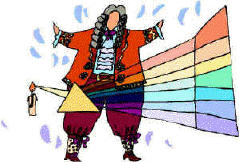BACKGROUND:
The world is full of images for
children. A reflection in a mirror or window can scare them; a penny in
a pool may look closer than it really is. Light has always played with
our sense of sight. Children can learn how these images are different
from the real thing. Children need to discover that they can change the
way light moves. As children play with optic toys, they begin to see
that light can play tricks with their eyes.
Young children need to experience
different examples of reflect and refract to recognize them easily.
Reflect is easier to understand than refract. Reflection is just a
"bouncing" back of an image, while refraction is a change of
direction of an image. A prism, for example refracts or bends light to
create a rainbow.
However, with just a little guidance,
students can look at light and identify whether it refracts or reflects.
PROCEDURE:
In this lab, students
will "play" with light. Students will view several examples of
reflection and refraction and will try to discover how light moves.
-
Display different
types of objects that reflect and refract. Common objects include
mirrors (reflect); glass of water with spoon in it (refract); foil
(reflect); oil in a glass bottle (refract); prism (refract); glass
(refract); lens (refract); or any shiny surface (reflect).
-
Instruct students
to shine light through the different objects and have them record on
their lab sheet whether the light is refracted or reflected. Instruct
them to write in the object and then the word "reflect" or
"refract."
-
Students should
look at the Swift GH and then look through the optic tube. The light is
refracting through the tube. Ask the students how they can get more
light through the objective. Give them the word "mirror" as a
clue. The mirror can help concentrate light through
"reflection" and then help to illuminate an object better. The
Swift GH uses reflected light. The light bounces up from the object
through the lens in the objective. The light then is refracted through a
series of lenses. Then you see the image through the eyepiece.